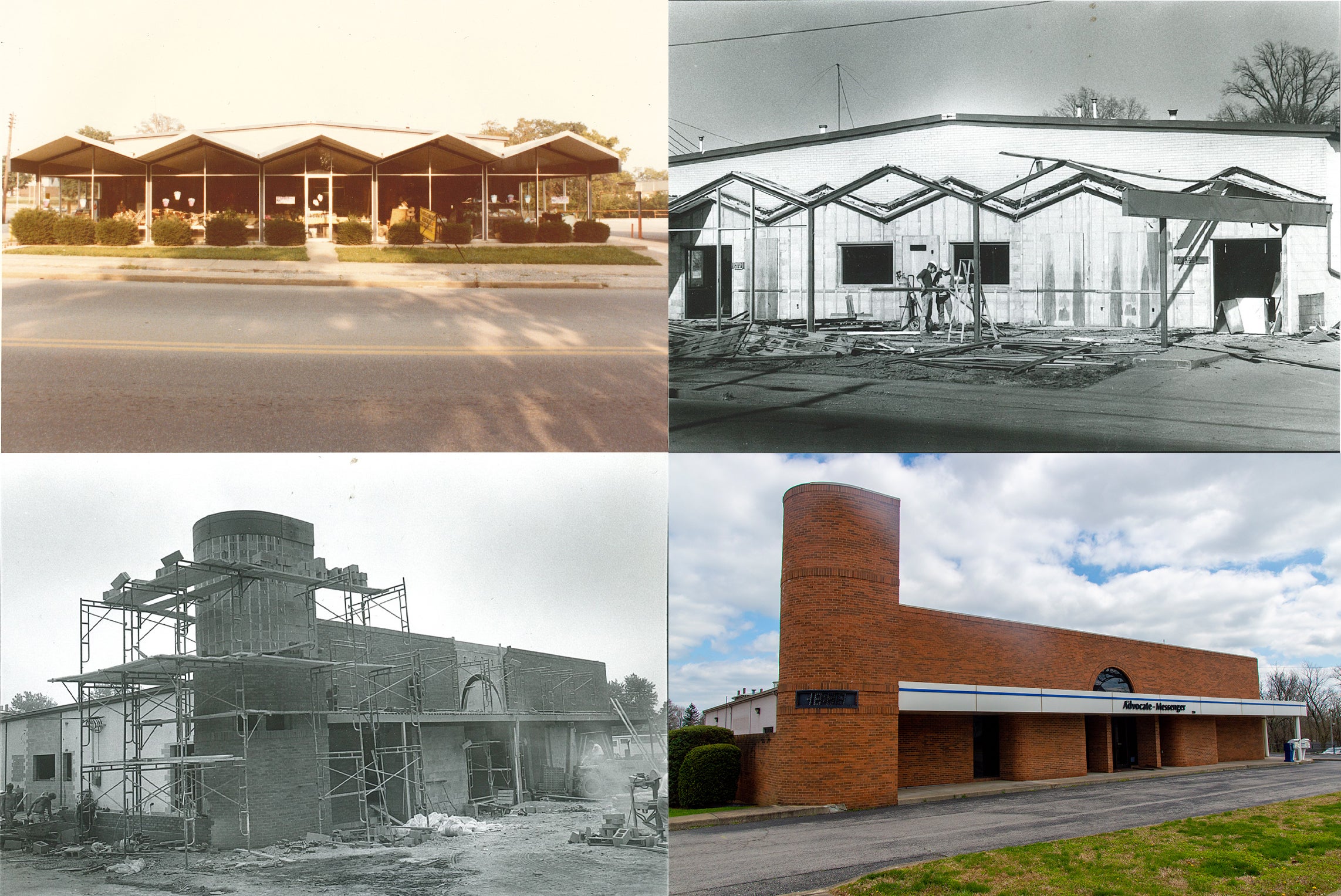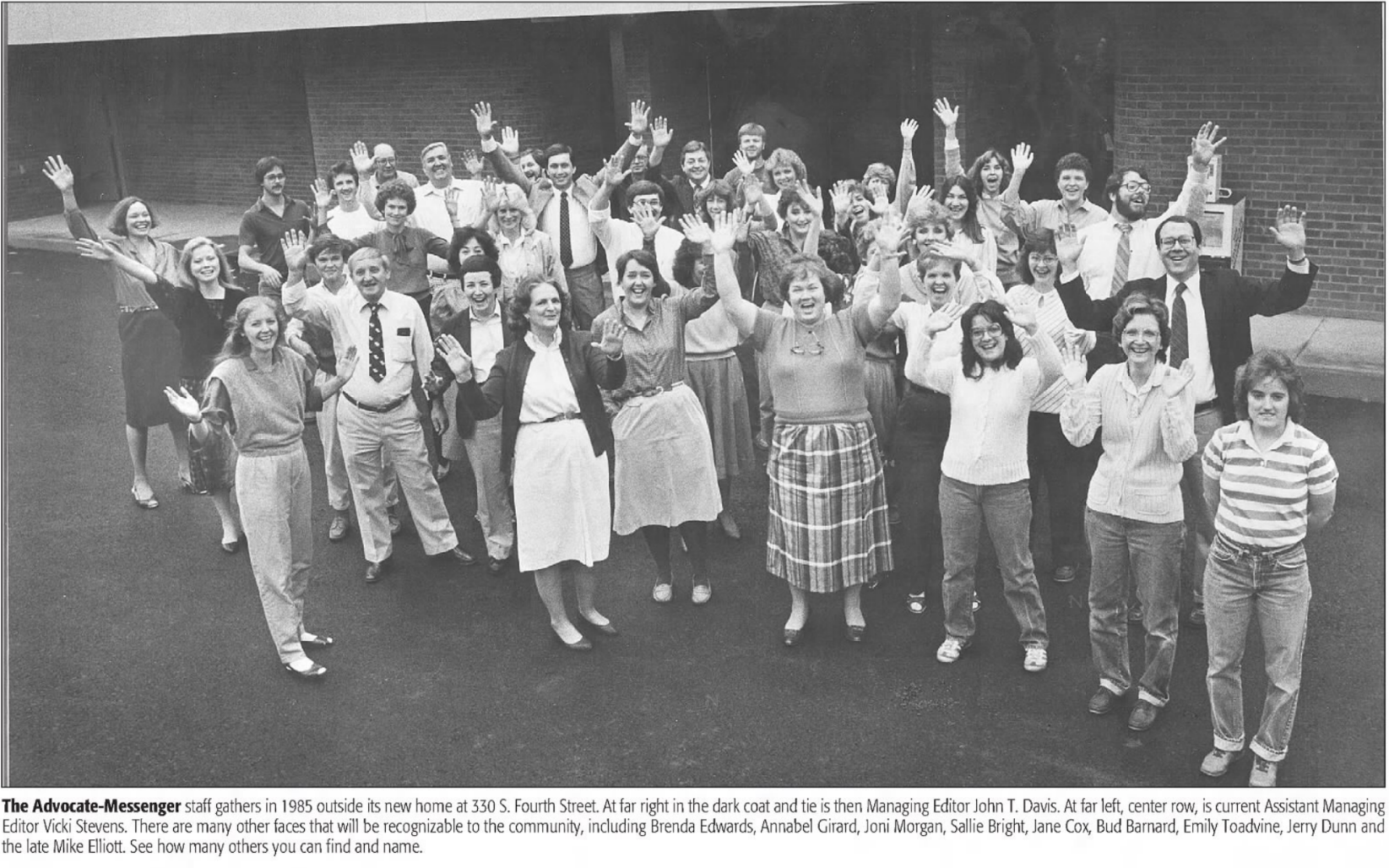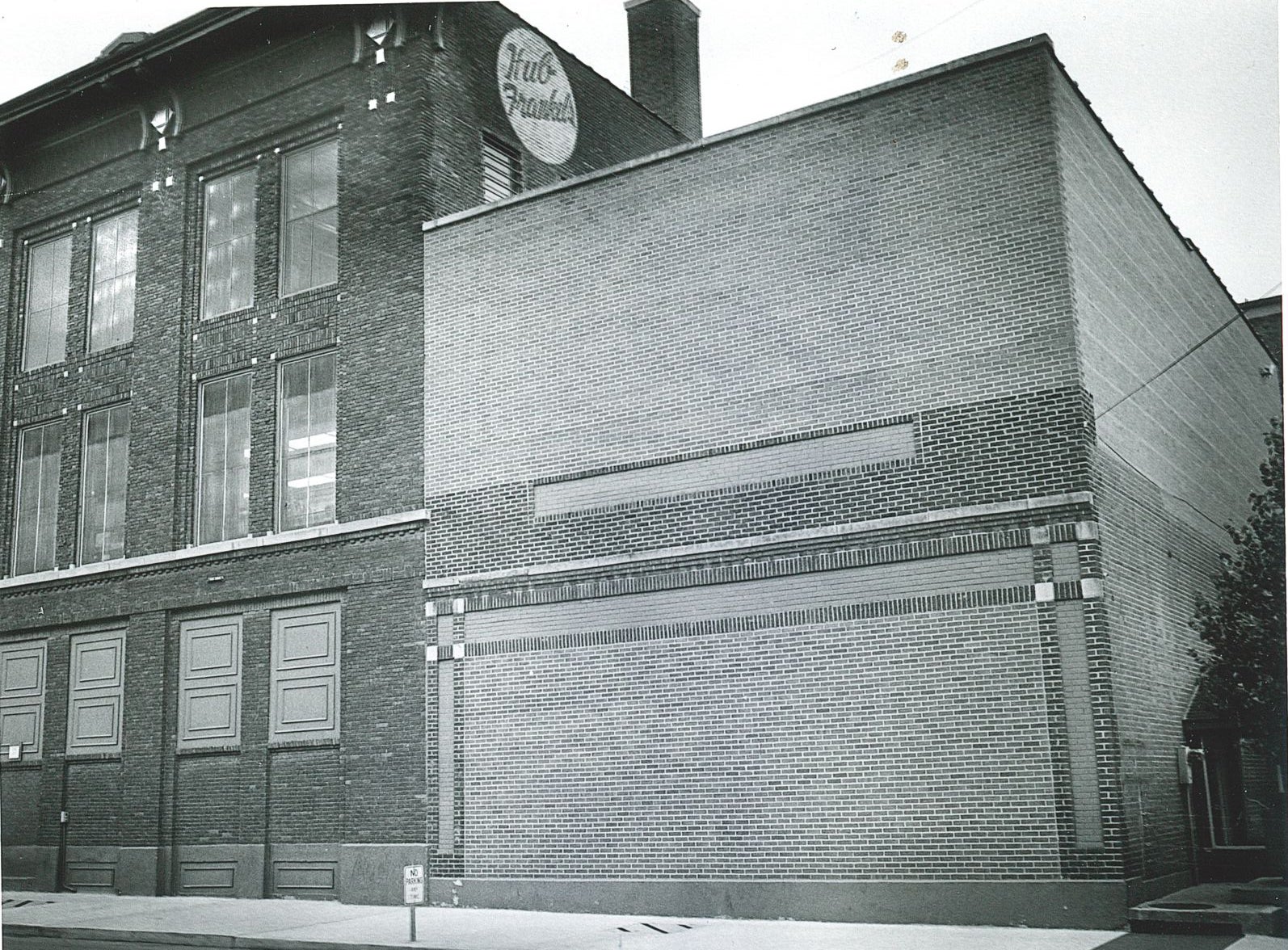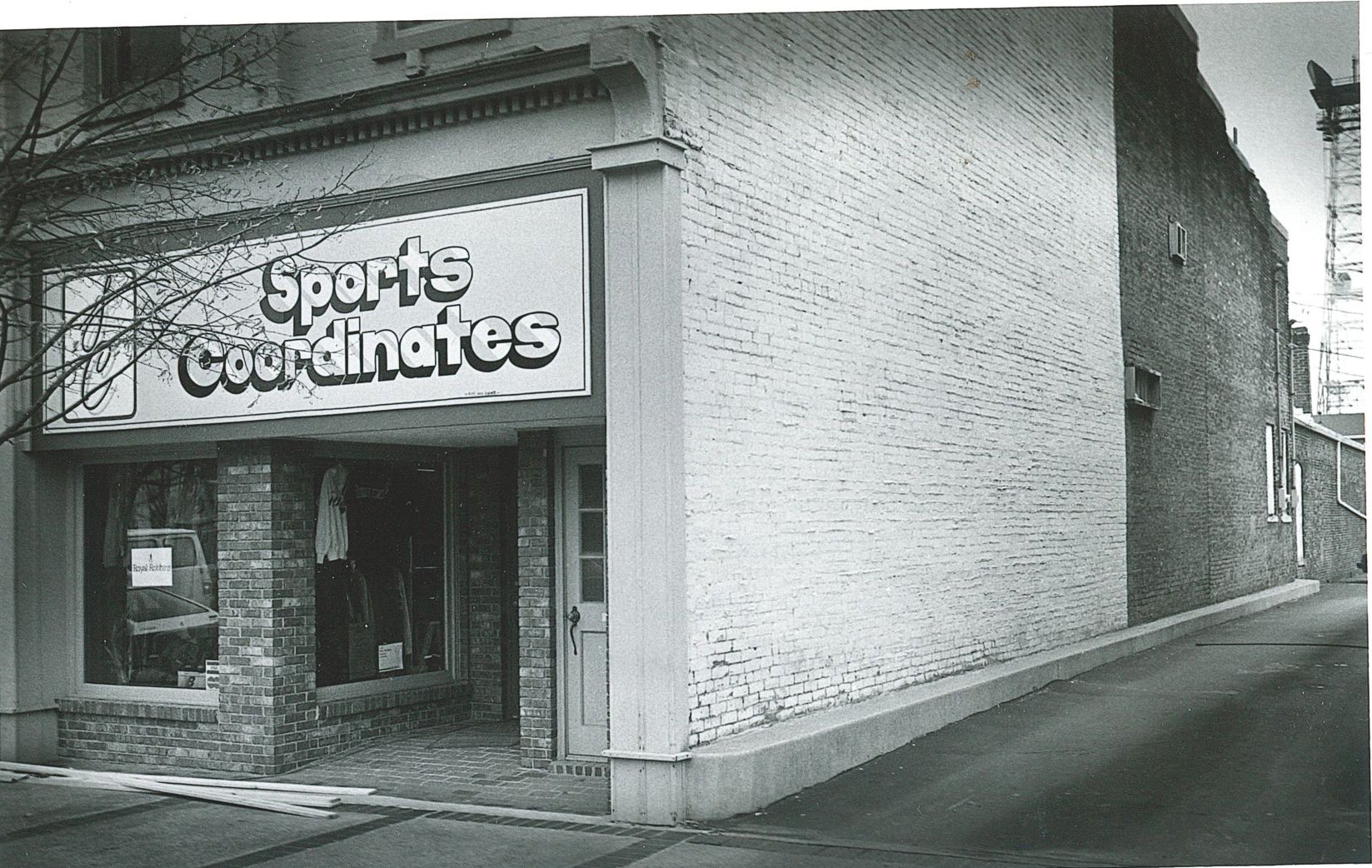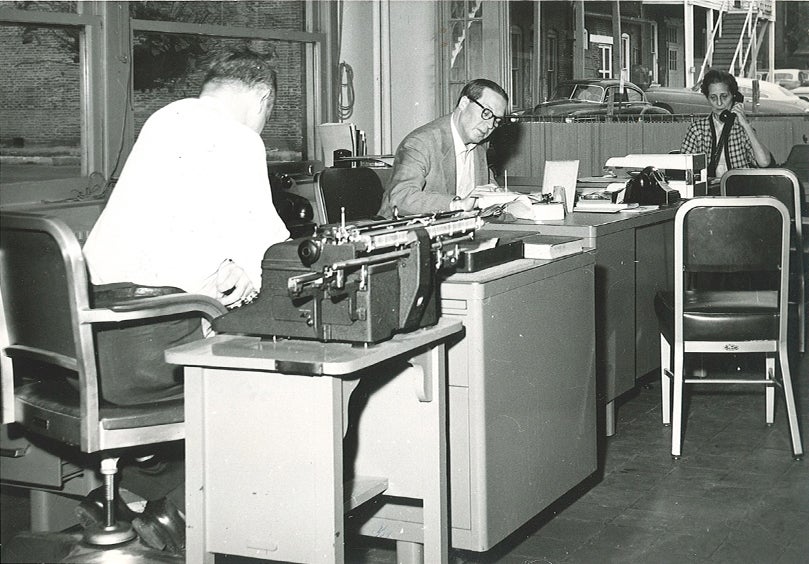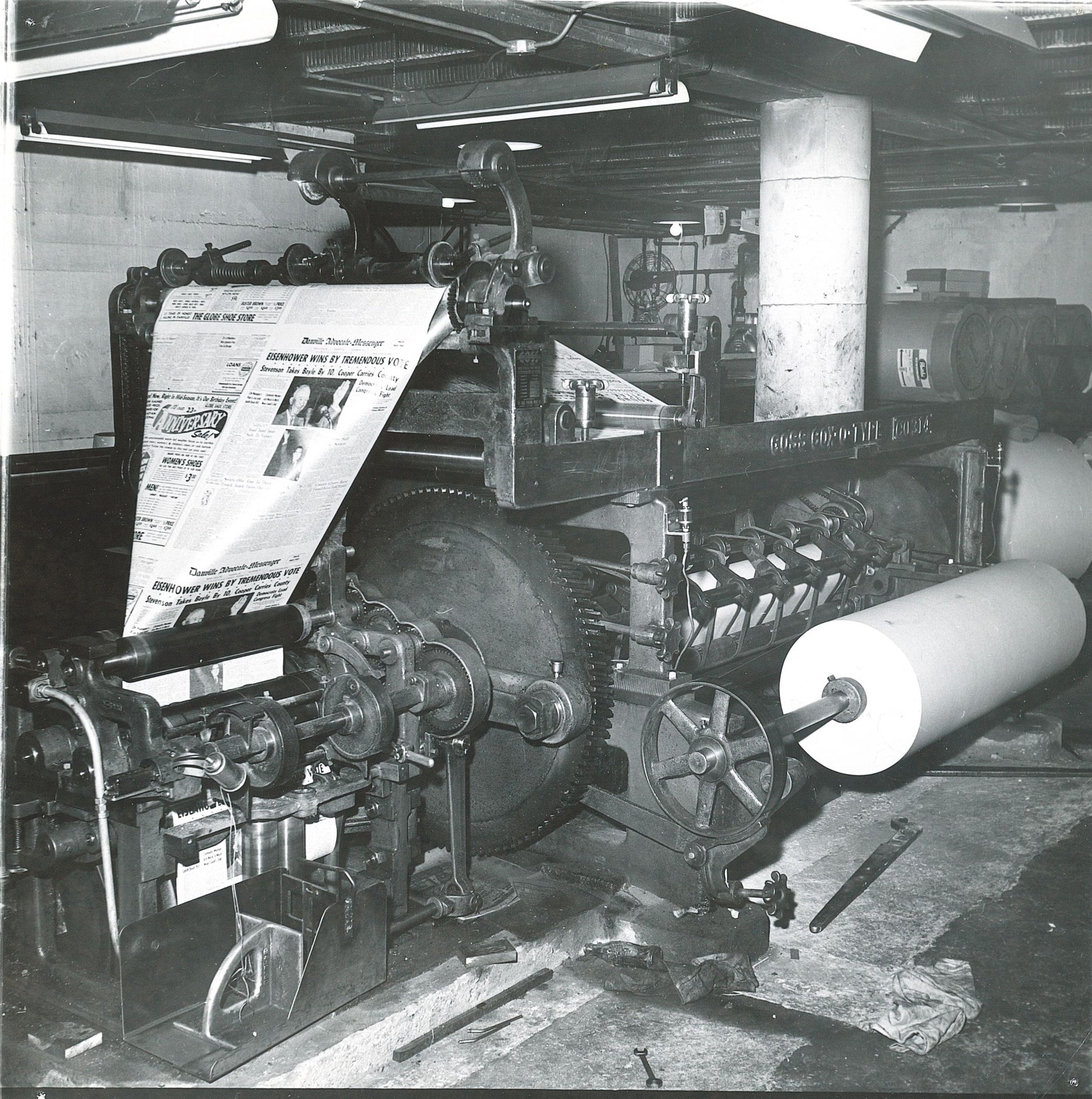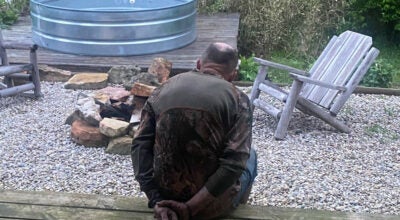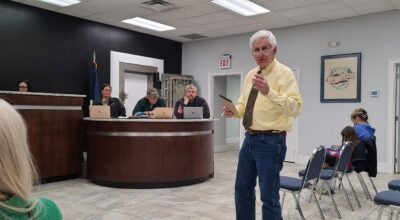A Community Cornerstone: History of the Advocate-Messenger from 1865 to 1985
Published 6:03 pm Wednesday, April 13, 2022
The following story was written by late former editor Enos Swain, and originally published in the November 15, 1985 issue when the Advocate-Messenger moved into the building at 330 S. Fourth Street. The Advocate moved out of that building on April 1 after 37 years. This story details the newspaper’s history from its beginnings in 1865 to 1985. The next issue will feature a story about the newspaper’s history from 1985 to now, and will tell about life in the old building.
When 25-year-old James R. Marrs started the Kentucky Advocate as a weekly newspaper in Danville in 1865, he founded what was destined to become the oldest business in town and one of the oldest continuously operated newspapers in Kentucky.
Marrs started working for the Kentucky Tribune, published by his brother-in-law James Zimmerman, at the age of 14. The Tribune had been the leading newspaper in Danville for a number of years, but by the close of the Civil War, Marrs was correct in estimating local conditions business, civic, and political were right for launching a new newspaper. The old Tribune office had been destroyed by the fire of 1860, but whether that had anything to do with the launching of the new journal, we don’t know.
Where the first office of the Advocate was located is also not known today, although records show that by 1877, Marrs purchased a lot “on Main Street opposite the Clemens House” (now Weisiger Park), and there he constructed a building in 1887. The Advocate operated in this building (which it called Main and Fourth until the merger with the Danville Daily Messenger in 1940.
The following account of Marrs’ stewardship was published in an article by Richard W. Griffin in an article in the Advocate’s 100th Anniversary edition: “He used his 20 years as editor to boost Danville and to appear in the vanguard of all the important improvements of the town. He favored progress and reform and took a prominent place in the politics of the county if not the city for during his incumbency the city was dominated by the opposition Republicans.
Since his influence was limited politically in the city he devoted his attention to the upbuilding and prosperity of Danville, The Advocate pushed the building of a gas works, a new hotel and made efforts to attract the Cincinnati Southern railroad shops to the town. He supported the installation of gas lights on the city streets in 1884 and the purchase of firefighting equipment.
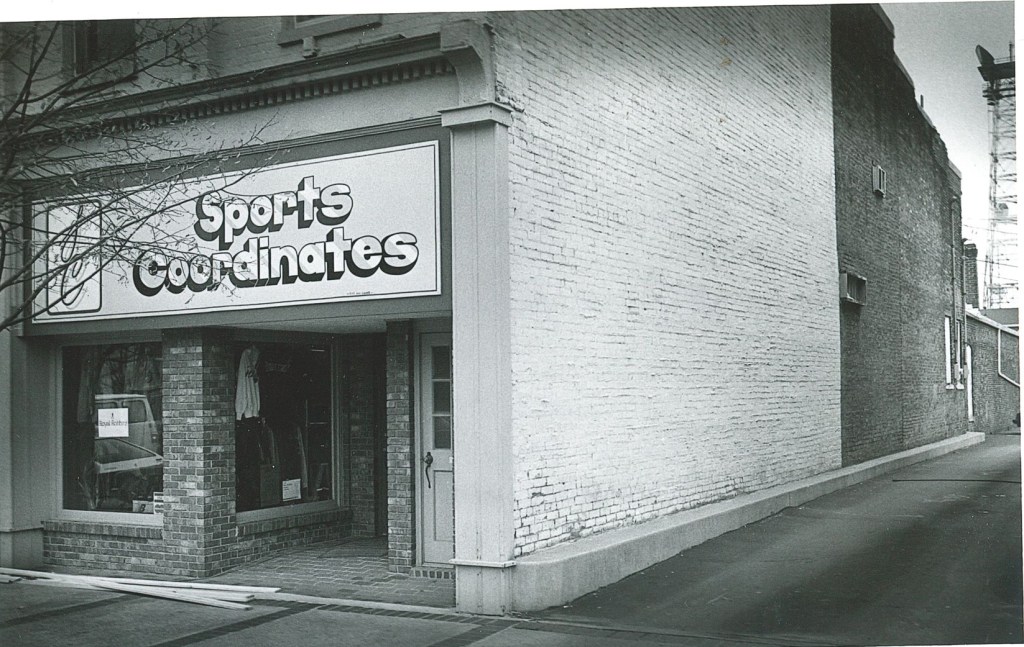
This building on Main Street served as the home of the Kentucky Advocate in the late 1800s until the merger of the Advocate and the Danville Daily Messenger. The merged newspaper moved to another Main Street property in 1943.
The Advocate was a consistent supporter of entertainment and reviewed the many traveling shows that came to James Hall, as well as activities of local thespians.
In 1876 The Kentucky Press Association met in Danville and Marrs was one of the hosts. He advocated for better schools, lauded the success of the Danville Blue Stocking baseball team, and proposed that a local historical society be formed to preserve Danville’s past. When the city acquired three fire engines in 1877 he became the volunteer lieutenant of the smallest, which was named by its team the “Rosebud.”
Marrs was a founder and consistent supporter of the Central Kentucky Fair, which was founded in 1855 and drew numerous visitors to the town. He supported the establishment of a telephone system in Danville and was one of the first 14 subscribers for its service. This early phone system did not work well and people were not accustomed to its idea and it was shortly abandoned.
In 1883 he supported the establishment of standard time but it was not popular and the Board of Trustees returned to sun time. In 1884, he worked to have local citizens urge the removal of the state capitol from Frankfort to Danville, the legislature was then considering abandoning the former place for a new location to be selected. In that year he also began a campaign for free turnpikes in Boyle County, urging the county court to buy out the stockholders of the many private turnpike companies.
In 1855 Marrs resigned his position with the Advocate to accept an appointment as the Danville postmaster from newly elected President Grover Cleveland. It was the first opportunity the party had to reward him for 20 years of faithful service in Boyle County.
After leaving the post office in 1890, Marrs founded the Central Record in Lancaster. In 1892 he became deputy collector of Internal Revenue, but left that office after a short time to return to Lancaster. He was also the founder of the Farmers Home Journal in Lexington. This farm weekly was later moved to Louisville and published successfully for a number of years. Marrs died in Danville in 1895 at age 55.
The departure of Marrs to become postmaster caused the first reorganization of the Advocate editorship and staff, resulting in the appointment of Samuel G. Boyle as editor and H.E. Woolfolk, his brother in-law, as business manager Boyle was the son of Gen. Jerry Tilford Boyle, a Danville native and the son of Chief Justice Boyle for whom this county was named in 1842.
The Advocate was thus in the hands of one of the leading families in the community Samuel G. Boyle, educated at Centre College and John Hopkins, remained only two years and turned the editorship over to Craig Ralston. Boyle was later editor for a time of the Lexington Herald and at his death in 1927 was secretary-treasurer of the Louisville Street Railway Company.
As editor of the Advocate, Ralston was credited with establishing the Citizens Charity Fund, or Nickel Fund, for relief of the poor in the community. Each subscriber was asked to contribute $2.60 per year, or a nickel per week. This fund once provided the only organized charity in Danville.
He urged building an electric light plant in Danville because the gas works was proving unsatisfactory. In 1888, the newspaper came out in favor of a water works, a public library, a fire department, a new school building, and the planting of trees on the town’s streets. All of these projects became a reality in time and says something for the Advocate’s claim of contributing to the unusual qualities of Danville as a place to live.
By 1892 the newspaper had reached a place of solid strength with the appointment of Woolfolk as editor and another Boyle brother-in-law, BG, Boyle, as business manager, and HJ. Giovanoli, a recent Centre graduate, as city editor.
Some lingering opposition existed in the form of the Danville Democrat, a successor of the Kentucky Tribune, but the Advocate continued to prosper and to propose change. In 1902 local mail delivery was started in Danville and the Advocate led the citizens in a movement for a new federal building. The plan for a new electric plant was again taken up and in 1906, Editor Woolfolk was elected mayor.
The Democrat, remnant of the old Tribune, discontinued operation in the depression, but new papers had been established, and there was no news monopoly in Danville until 1906 when Woolfolk’s retirement opened the way for a three-way merger of the Advocate, the News, and the Herald.
This brought together the talents of W Reed Embry, W. Ver. non Richardson, and W Owen Mclntyre, the latter two for the rest of their active lives. B.G. Boyle had left Danville in 1898 to become business manager of the Louisville Evening Post and later moved to Chicago as editor of the bankers’ directory of the Rand McNally Company.
Giovanoli resigned to go to Washington when John W. Yerkes became collector of Internal Revenue in the Theodore Roosevelt administration. He became the collector’s administrative assistant and later chief clerk of the bureau. He was afterwards editor of the Lexington Leader and retired to Florida in the 1920s.
Embry, who was formerly one of the owners of the Danville News, remained with the Advocate for only a short time, and by 1901 the paper was being run by McIntyre and Richardson and George W. Doneghy, a nephew of Marrs, the founder.
The economics of the newspaper business had not reached the stage that later gave great encouragement to the monopoly press, so in 1910 a new journal, The Danville Messenger was started by Hubert McGoodwin, a local merchant and city treasurer.
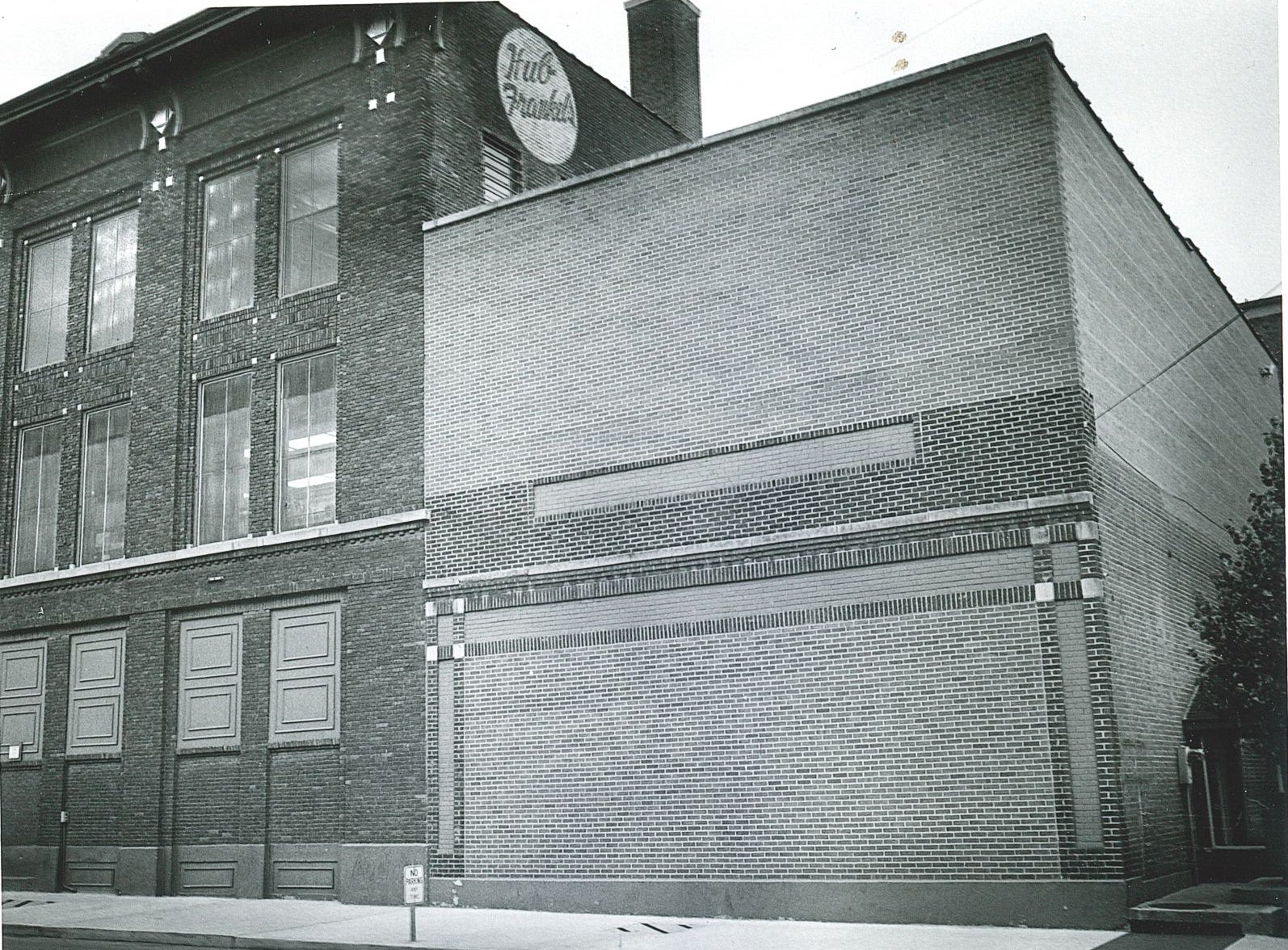
The Danville Daily Messenger in the 1940s and earlier occupied part of the first floor and all of the basement of the Hub Frankel building. It is now The Hub coffeeshop and Centre bookstore on the first floor, and CentreWorks on the third floor.
McGoodwin’s feelings were hurt by a news report in the Advocate following a city council meeting, which described the treasurer’s report as “written with pencil on a piece of butcher’s paper.” He considered this report insulting and was so angry he took the next train to Cincinnati and bought a linotype machine, announcing on his return home that he was the founder of a new and proper newspaper in Danville.
The Advocate’s response was to go to daily publication (Monday through Saturday afternoons) although it was one of the smallest daily newspaper publications in the country at the time. Three years later the Advocate joined the Associated Press, and McIntyre and Richardson remained in control, changing titles occasionally to suit various other activities, until McIntyre’s death, followed later by the merger of the Advocate and Danville Messenger in 1940.
Both Richardson and McIntyre were interested in politics and the Democratic Party. McIntyre was mayor of Danville from 1916 until his death in 1933. He built the first permanent streets in Danville, opposing many leading citizens who feared higher taxes would follow, modernized the light system, improved sanitation and rebuilt the water system. He was a great advocate of new and better roads, and promoted for many years the organization of highway tourist routes from all directions to the main street of Danville.
During this period Richardson served as administrative assistant to U.S. Senator Ollie James in Washington for a number of years, served a term in the state Senate, and was later a member of the Kentucky Board of Charities and Corrections. He was a proverbial politician–in favor of everything good, which the people wanted and supported, and opposed to everything which the people opposed and did not want. His great interest was in Centre College where he graduated in law in 1897, and in its students, friends and alumni. He kept up with alumni in all parts of the country and his daily column Just A Minute Please’ was filled with praise of former Centre students, dubbed by him as Noble Sons of Centre,’”
Meanwhile, the Messenger was purchased in 1918 by J. Curtis Alcock and was launched as a daily competitor of the Advocate in 1919. Alcock, a native of Glasgow, had worked for a time in Bardstown before establishing The Jeffersonian in Jeffersontown, nearLouisville. Alcock always had a competent newsman on his staff among them Charlie McDowell, later dean of law at Washington and Lee University, George A. Joplin Jr., later publisher of the Somerset Commonwealth, J. Sterling Towles, who left the Messenger and later returned to the Advocate-Messenger, and numerous others. At the Advocate during these years, the burden of daily news reporting and editing was handled by W.C. Mehan, who later was with the Arkansas Gazette in Little Rock, and who now lives in Lexington. Competition during the depression years of the 1930s was fierce between the two Danville afternoon newspapers, published next door to each other near the corner of Fourth and Main.
Alcock’s more careful attention to details, both in collecting and editing local news, and in advertising and business aspects of the publishing business, gradually gave the Messenger a little advantage over the older newspaper. With help from J.S. VanWinkle, a Danville investor, who had from time to time owned shares in both newspapers, Alcock was able in 1940 to consolidate the two into The Advocate-Messenger. The scheme of the merger was to publish The Advocate-Messenger daily from Monday through Friday, and to bring out a Saturday afternoon publication pre-dated Sunday and named The Kentucky Advocate.
After the merger the old Advocate office was closed and the new newspaper was located in the Messenger office on South Third Street, across from what was then the Durham Hardware store, just south of Hub Frankel.
Unfortunately by 1942 both Alcock and VanWinkle had died. Their widows, with the help and counsel of their lawyers, Chenault Huguely and Joe G. Davis, undertook to carry on the business, at least until W. Chauncey Alcock, son of J. Curtis Alcock, could return from military duty at the end of World War II. Chauncey Alcock was secretary of the merged company and had worked in the Messenger office before the war.
They first employed W.L. Simpson of Mount Vernon as editor and manager, but two years later secured the services of Enos Swain, alumni secretary and director of public relations at Centre College and formerly a news reporter for the Danville Messenger, Harrodsburg Herald and Somerset Commonwealth.
Swain assumed his duties in May 1944, and served the longest tenure of any editor in the newspaper’s history. W. Chauncey Alcock served with him in the capacity of associate or executive editor.
It had been J.C. Alcock’s goal since his arrival in Danville to consolidate the local newspapers into one publication, but the economics of the industry were never helpful until the combined efforts of the Great Depression, World War II and the advent of radio. With the Messenger, he had published a lively and interesting paper and had taken the roles of community leadership formerly exercised by the Danville editors since James Marrs. He served a term in the Kentucky legislature (1928-29) and was chiefly responsible for the establishment of Perryville Battlefield State Park. He was partly responsible for reorganization of the Danville and Boyle County Historical Society in preparation for the state’s sesquicentennial celebration in 1942, and through the 1930s was actively involved in industrial development and establishment of Constitution Square State Park.
The new Advocate-Messenger of 1944 and the following few years began a slow and tedious path of gradual growth and acceptance. Much success was due to the tireless efforts and brilliant work of Ida M. Tipton, who served as city editor and was responsible for the unusual and complete coverage of local news. She was later succeeded by J. Sterling Towles and Bob McNemar.
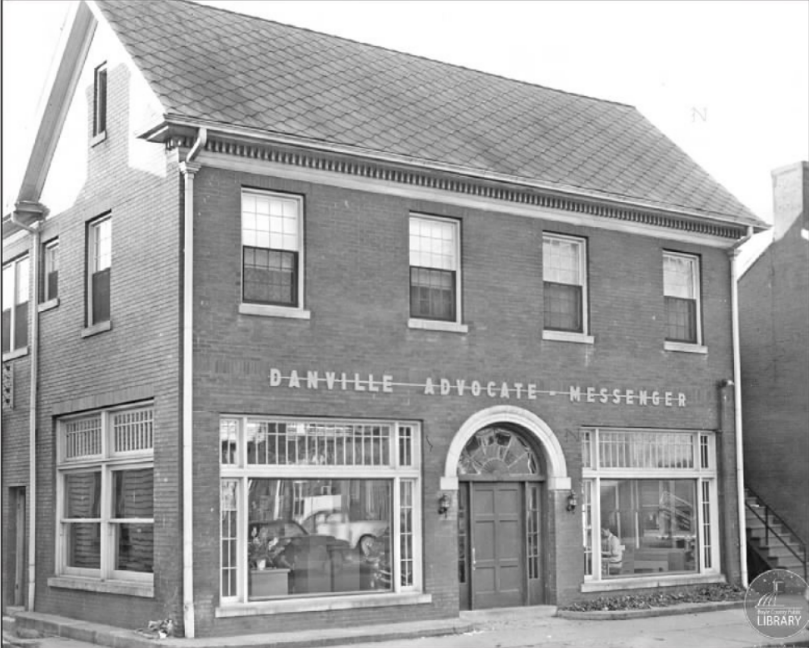
The Advocate-Messenger’s location at the corner of Fourth and Walnut street before moving to 330 S. Fourth Street.
Several major changes affected the progress of the paper in those years. In 1950 the Saturday pre-date was discontinued and the Advocate was changed to a genuine Sunday morning newspaper, printed about 10 o’clock Saturday night and delivered Sunday morning. Soon afterwards the Advocate-Messenger joined the Audit Bureau of Circulations, coming up with a certified paid circulation of almost 3,000 copies daily.
In 1963 the Advocate-Messenger changed to the newly invented off-set method of printing, becoming the second daily in the state to invest in a new offset press, eliminating the mechanical methods in use for a hundred years and making it possible to handle twice as many pages of news and advertising as before.
This was not without risk at the time, as many experts predicted the new method would never be suitable for newspaper production. Because of increased production capacity, faster production, and reduced press time, a decision was made to go for circulation beyond the borders of Boyle County. With staff additions the effort was launched to establish a regional, rather than local, newspaper. A five-county region was staked out and circulation gradually increased to 10,000 subscribers in Boyle, Mercer, Lincoln, Garrard and Casy counties. That figure now is in excess of 12,000 and it is not unusual on big news days to exceed 13,000 copies.
Because of the Advocate’s success as a regional daily, the management decided in 1975 to go out of the job printing business, except for jobs printed on newsprint on the newspaper press. This resulted in the sale of all the company’s commercial printing equipment to Bluegrass Printing Company, and freed the paper’s employees to spend all their time on the newspaper.
The next major event in the history of the newspaper, and the last one we can account for at this date, was the decision in 1977 to sell the business to Schurz Communications Inc. of South Bend, Ind. A closely held family newspaper and communications company, the Schurz organization owns properties in South Bend, Bloomington and Bedford, Ind.; Hagerstown, Md.; and several other locations, besides Danville. Their reputation in the industry is the highest and their expression of confidence in Danville and its future is evident in the new building, plant and equipment installed on South Fourth Street as the new home of The Advocate-Messenger.
Mary Schurz, daughter of the founder and former president of Schurz Communications, has already served as editor and publisher of The Advocate- Messenger seven years. Under her leadership the paper has continued to prosper and grow and serve the community and its needs in keeping with the traditions of the past.
See part 2 of the newspaper’s history in the next edition.


